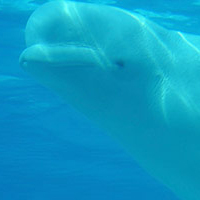Beluga
Scientific name: Delphinapterus leucas

Cover photo credit: istockPhoto.com
Status
Special Concern
“Special Concern” means the species lives in the wild in Ontario, is not endangered or threatened, but may become threatened or endangered due to a combination of biological characteristics and identified threats.
Date added to the Species at Risk in Ontario List
The Beluga was already assessed as a species of special concern when the Endangered Species Act took effect in 2008.
What it looks like
The Beluga is a relatively small mammal compared to other whales, normally reaching about four metres long and weighing about one tonne. Belugas have white skin as adults (young Belugas are a soft grey), a dorsal ridge rather than a true fin, and a pronounced “melon-head”.
Belugas are social and very vocal. They produce a wide range of complex sounds for communication with other individuals. Most of these calls can be heard by humans, especially when these whales congregate in shallow waters in the summer.
Where it lives
This species prefers slow-flowing streams which have abundant plant cover within the stream. In addition, a key part of the species habitat is an abundance of vegetation on the stream banks. These vegetated areas are important habitats as they provide areas where the species can hide from predators and where they can find food.
Where it’s been found in Ontario
Belugas are migratory. In summer, they congregate in river estuaries and shallow bays, where they moult and calve. In the fall, Belugas migrate to areas of open ocean that remain open during winter. Individuals from Ontario usually winter in seas off Baffin Island, where they mingle with individuals from other populations.
What threatens it
The last count of Western Hudson Bay Belugas was in the late 1980s, when aerial surveys estimated the population size at about 25,000 whales. While there are no recent data on population trends, there is concern that hunting pressures have increased on the Ontario population since the last census.
Other threats include disturbance from increased freight shipping in the Hudson Bay area. There is some concern that shoreline disturbance from hydroelectric development in Hudson Bay lowlands could change the river estuary and bay habitats, and hence impact the summer population.
Action we are taking
Special concern species do not receive species or habitat protection.
Management plan
A management plan advises the ministry on ways to ensure healthy numbers of the species return to Ontario.
Read the management plan (June 28, 2013).
Government response statement
A government response statement outlines the actions the government intends to take or support to help recover the species.
Read the government response statement (March 7, 2014).
What you can do
Report a sighting
- Report a sighting of an endangered animal or plant to the Natural Heritage Information Centre. Photographs with specific locations or mapping coordinates are always helpful.
Report illegal activity
- Report any illegal activity related to plants and wildlife to 1-877-TIPS-MNR (847-7667).
Quick facts
- The name “Beluga” means ‘the white one’ in Russian.
- The Beluga’s enlarged forehead is involved in echo-location, in which clicks are emitted to help locate prey and aid in navigation under ice. The forehead is thought to focus the clicks.
- To feed, Belugas spend a lot of time under water. They are capable of frequent dives of 400 to 800 metres. The deepest dive recorded from a male Beluga was in excess of 1,000 metres.
- In captivity, Belugas consume about 10 to 15 kilograms of food every day.
- Belugas are warm-blooded, with about the same internal body temperature as humans. Their blubber layer, 2.5 to 9.5 centimetres of fat lying immediately below the skin, helps to maintain their body temperature in ice-filled waters.